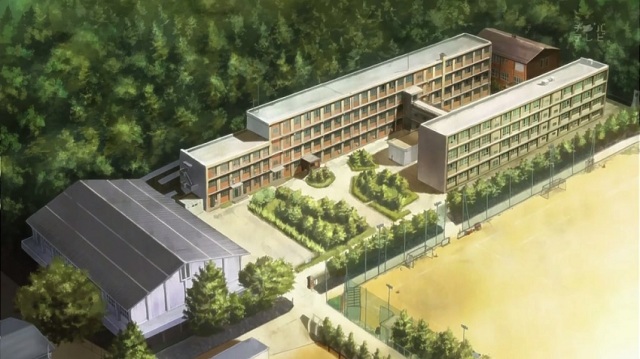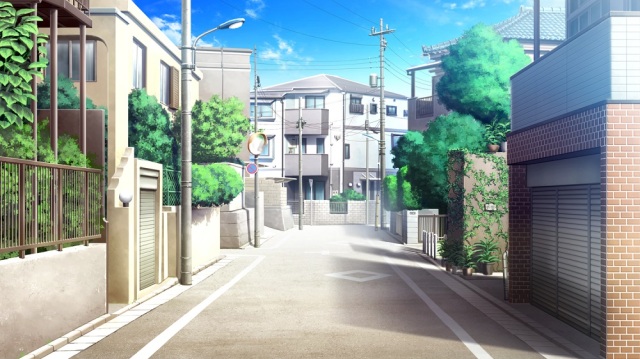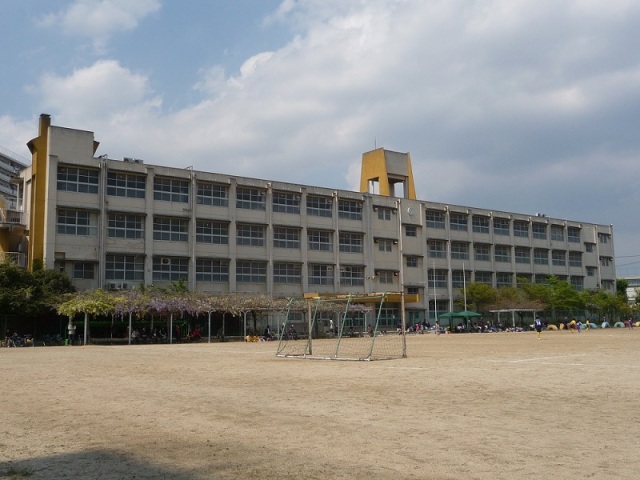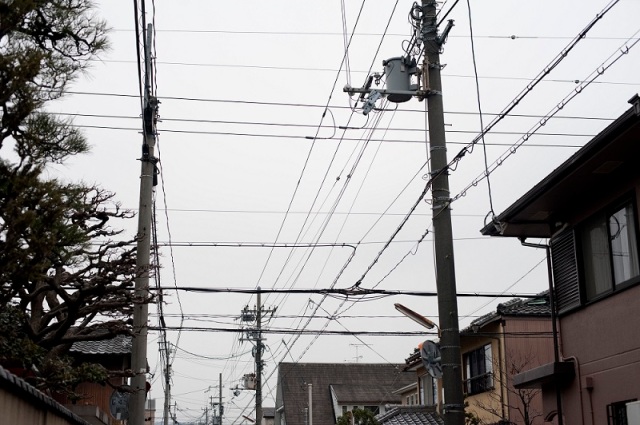Anime is a medium that loves to exaggerate. From the overlarge eyes and sometimes hilarious facial expressions to the often outright fantastical stories that occur in ‘real life’ situations, there’s clearly a lot about anime that is in no way comparable to the actual world in which we live.
That being said, there are also plenty of common features in anime that do in fact reflect what life can be like in Japan. Viewers might not necessarily watch anime for its realism, but it’s difficult to divorce an entire culture and its customs from a product, and as such, many anime titles are automatically reflective of the place in which they are created. In this collaborative article between Artemis and myself, we’ll be going over a few of the more pervasive examples of those anime tropes that are more or less identical to the sights and sounds of Japan in reality.
Let’s start off with one of the most obvious: school. Ever caught yourself thinking that nearly every single school building in anime looks exactly the same, from the outside architecture to the inside layout? That’s not just because the art department is being cheap or lazy (well, okay, maybe sometimes that too), but also because the vast majority of schools in Japan really do look like this. Whether they’re elementary, junior high, or senior high schools, the bulk of these buildings are designed in such a way that they’re instantly recognizable to anyone who happens to be passing by: box-like and stark concrete, with multiple storeys depending on the number of students (but typically at least three), and a clock situated somewhere above the main entrance. The ‘field’ out in front isn’t grass but rather a sandy kind of dirt, where the kids can play baseball, the bugs can’t thrive, and the school doesn’t need to do anything but rake and occasionally weed it.
Perhaps in part because of how relatively easy and cheap they are to build and maintain, and possibly also because of Japan’s almost fanatical passion for uniformity, there are precious few public schools that don’t adhere to this basic appearance; the Japanese government simply doesn’t permit many breaks from the norm. And of course, since schools essentially look indistinguishable from one another no matter where in Japan they’re situated, it only makes sense that most anime schools set in Japan look pretty much the same as well, from classics like Sailor Moon and Great Teacher Onizuka to more contemporary shows such as Hyouka and Gekkan Shoujo Nozaki-kun.

Take it from me that they sound precisely the same as well, thanks to the chime played in Japanese schools the country over. Known as the Westminster Quarters, this distinctive tune is actually one of the most, if not the most, common piece of music played by clock chimes around the world. Though adopted by the clock tower at the Palace of Westminster (where Big Ben hangs) in the mid-18th century, the tune is not only heard plenty in England but also for example in Taiwan, where as in Japan, the sound signals the beginning and end of class periods. It’s also a common sound at train stations in Indonesia, where the tune is used to indicate train arrival and departure times.
Although the reason why Japan decided to use the Westminster Quarters specifically as the nation-wide school bell is something of a mystery, it’s said that the reason it was changed from the previous bell is that it sounded too much like an air-raid siren. Perhaps the choice of a British tune was inevitable, given that the sailor fuku is also modelled after the uniforms of the Royal Navy. In any event, the Westminster Quarters has now been closely associated with the Japanese school system for over half a century, and so the sound has practically become its own establishing shot as far as anime is concerned. Tenchi Muyo, Cardcaptor Sakura, Toradora, K-On – take your pick, the chimes are nearly always the same.
However, this isn’t the only sound heard in a huge number of anime. Another noise common to hundreds, likely thousands, of anime titles is that of cicadas. Cicadas in New Zealand can be loud. Cicadas in Japan are generally much bigger but also much, much louder, and for three to four months in the summer, they scream from dawn until dusk. Some don’t even stop there, since the big cities create so much illumination that the poor things apparently get confused and keep going well into the night. What’s more, there’s something like thirty different species of cicada that can be found throughout Japan, all of which produce their own unique sound.
No matter if you live out in the countryside or in urban Japan, the noise of chirping cicadas is so noticeable and so unrelenting that to omit it from an anime set in Japan during summer might feel a little odd. As a result, it’s not just anime like Natsume Yuujinchou, Barakamon, and Non Non Biyori that take place in rural settings which heavily feature the sound, but also titles set in the city. One of the subtly unsettling things about Evangelion, for example, is that even in a big post-apocalyptic city like Tokyo-3 the sound of cicadas never stops, because the world is in a state of perpetual summer.
Moving away from the future and back into current-day Japan, another thing that anime consistently gets right is the look of the streets in a modern Japanese town. It’s quite distinctive and you’ve probably noticed it yourself if you’ve watched any anime at all, but it was only after our respective arrivals in Japan that we realised just how accurate this portrayal is. There are three main aspects to it which are immediately noticeable: the streets themselves, the buildings which line them, and what this does to the amenities we would normally take for granted.
Streets in Japan are narrow – really narrow. Partly this is traditional, partly it’s the way property taxes are calculated, but the end result is that real estate is at a premium. Even most main roads aren’t generously proportioned by Western standards, and once you get off them and into the side streets they get even more cramped. Shows with a slice-of-life focus like Bakuman and Usagi Drop get the look and feel absolutely right. To cope with the confined streets and sharp angles, innovations like kei cars make a lot of sense. If you’re not sure what a kei car is, you’re not alone – I’d never heard of them before I came to Japan either. Calling them small is to miss a perfect opportunity to use the word diminutive, but they still manage to fit in a 660cc engine and usually four seats. Their short wheelbase and low fuel consumption make them very popular in towns here (and the different taxation requirements don’t hurt either.)

The same factors that influence such narrow streets also apply to the buildings that line them. There’s a strong pressure to get the utmost use out of every square meter of land, which means that houses and shops usually go right up to the very edge of the boundary. And this does precisely what you’d expect: gardens, roadside parking, and footpaths are remarkable more for their absence than their presence (or, if present, for their confined and regimented nature). Even roadside drains are affected by this, having a standardized design which is deep, small, and right-angled – and those that are not covered over present a real menace to navigation when trying to drive a car down a side-street. In any case, the combination of narrow streets with sharp angles and buildings right up to their edges means it can be difficult to work out when it’s clear to turn a corner, so circular convex mirrors are a common sight at intersections.
The other extremely distinctive feature of Japanese streets is the overhead cabling. It’s nowhere near as bad as it is in some other places like Vietnam, but it’s still something of a surprise in a developed country. Practically all power and communication cables are strung from poles at the side of the road, and even in big cities such as Tokyo, well over 90% of the power grid is located above ground. There are arguments both ways, of course; overhead cables are much cheaper and easier to install (and repair in the event of damage), and they provide handy places to put streetlights and signs. However, they’re also very vulnerable to bad weather, and can block road access in the event of a natural disaster. As you might imagine, even Japanese people are divided on the issue, and Tokyo is considering a concerted effort to clear at least some areas in preparation for the 2020 Olympics. Aesthetics aside though, the real issue preventing underground cabling being taken up more widely seems to be the cost and difficulty of doing so. There’s a lot of infrastructure already down there, and rearranging it all to make room for the cables might simply prove impractical. At any rate, overhead cables are certain to remain a feature of both rural and urban Japan for the foreseeable future.
Needless to say, just about any anime set in modern-day Japan has a lot of the above features, especially shows with a big emphasis on outdoor establishing shots like Kare Kano and Aku no Hana. However, if you’re after only one title which has examples of every single point discussed in this article (to say nothing of also being quite sweet and endearing), you could do a lot worse than checking out Kamichu!. The setting is based on a real-life location, and is absolutely convincing as a rural Japanese seaside town. It’s these kind of shows which go a long way in reminding me that although anime as a medium is often prone to intentional exaggeration, it’s also frequently more accurate than non-Japanese viewers might think.
Question of the post: What aspects of anime would you expect to be most reflective of real life in Japan? Are there any specific anime titles that you feel are especially authentic?




You hit on almost all of the ones I would have mentioned, especially the townscapes. I never would have guessed how uniform it would have been. But they also get food obsession right, and clothing. Whereas in American cartoons you get sort of a caricature of what regular people wear (a red shirt and blue pants), anime tends to keep up with the real fashion of the era it is produced in, with real folds, buttons, etc.
LikeLiked by 1 person
Interesting point, and not one I would have noticed probably. We were trying to steer clear of things about people, partly because living in the inaka it’s dangerous to generalise. Having been in Kyoto for almost a day now, though, I’m starting to see what you mean.
LikeLiked by 1 person
I hear you on the not over-generalizing part, but one thing I have noticed, also, is school boy haircuts. Of the Shinji variety. That’s pretty much a staple haircut, besides half mullets.
LikeLiked by 1 person
Yes, there seems to be a standard configuration for hair in a lot of places. It could be worse… Until I got to high school, my parents cut my hair with scissors and a bowl.
LikeLiked by 1 person
…I can only imagine! XD
LikeLike
Thankfully, no photos have survived from that era. None I’m putting up in public, anyway.
LikeLiked by 1 person
One good example of anime background realism (or accuracy) Girls und Panzer Episode 04 where the exhibition match between Oarai and St. Gloriana’s ends up in downtown Oarai. In this video, a GuP fan visited Oarai and compared backgrounds from the anime with RL Oarai locations.
LikeLiked by 1 person
That’s a good example! I’m told there are other anime which are very accurate to a specific location. It’s always nice when art mimics life like that.
LikeLike
LOL, diakama beat me to the Oarai reference. Your description of the overhead wires reminds me of some turn of the century (19th) US cities that were overgrown with telephone/electric lines. Seems dangerous in a country with the prevalence of earth quakes that they have. Some smaller things that you see often are things like what I call the “shoe kick” where they put on their shoes by tapping the toe against the ground and the seeming lack of heating and cooling in schools. Fireworks (Hanabi) seem to be a big thing also. I understand the bento’s for lunch but one thing I don’t get is the “bread” that you see the kids eating. Is this what I would call a sandwich or is it really just a flavored piece of bread?
OTOH, there are some things in anime that don’t seem to ring true such as the number of kids living on their own. Seems more like a wish fulfillment or maybe just a plot contrivance to put them in situations where they don’t have parental supervision. Not uncommon in western literature either(Huck Finn, Treasure Island, Captains Courageous, Oliver Twist). The other is the apparent lack of supervision by teachers. If they’re not actually teaching or in the office the teachers seem to be AWOL.
LikeLike
Dependent on the power delivery mechanism of Japan, a downed cable might not lead to the dangerous catastrophe you see in US TV shows with some multi-thousand-volt lump of metal jumping and sparking. If it’s engineered anything like the US (and I suspect some areas are, Japan’s national grid and even local power – with some areas at 110v and others 230v, some 50Hz and others 60Hz – are truly fascinating) then sure, that’s a problem. If it’s _not_ like the US though then a local substation would trip and that phase would go dead in a matter of milliseconds post cable-break before it even hit the ground.
Below-ground cabling can be an absolute bastard in a tectonically active region, imagine an armoured cable the thickness of your forearm being sheared as two regions move maybe 20cm relative to one-another. Then imagine how evil that would be to repair (both locating, getting to, then patching the break). At least overhead cables have a little slack (for temperature shifts and natural movement due to weather). The same holds for data cabling.
There are pluses and minuses to each; costs, dangers, aesthetics, maintenance requirements etc. The images of their modern installs look very neat.
LikeLiked by 1 person
They really are very neat – it certainly isn’t like the cats cradle you get elsewhere. And good point about the difficulty of repairing below-ground cables. I’ll bet thats occurred to others too, although overhead cables are easier to bring down in a storm I suppose.
LikeLike
Arguments both ways about the danger of overhead cables. Easier to bring down, but also easier to put back up. I guess a lot of it is the sunk costs in the already existing infrastructure, putting it all underground would be a huge hassle starting from now.
I’ve seen the show kick too, but haven’t got into the habit myself yet. And yes, the schools are woefully underheated in winter (in summer, at least you can open the windows). Bread here is… A bit odd. It might be a sandwich, or onigiri, or it might just be a bit of bread. Some pieces of breakfast bread have to be seen to be believed!
I’m fairly sure the number of kids living alone in anime is for precisely the reasons you describe – it’s a big help to the plot, and is probably understood as such (just like the spiky hair and improbably large swords).
LikeLike
Thinking a little more, one of the reasons bread is odd here is that people do things with it that aren’t normal in other countries. It might well be bread with stuff in it, like anko.
LikeLike
Another thing about bread in other nations is often the “sweetness” (for want of a better word) of even a plain sliced loaf. I noticed in the US and Indonesia that bread had a much higher sugar content than that in the UK, much of western/central Europe, or NZ. My palate was certainly not expecting that. Is it the same in Japan?
LikeLike
Yes! When I first arrived, it tasted like cake in comparison to what I was used to. It’s taken me a long time to come to terms with that. And it is also almost invariably white. When I managed to find some sandwiches made with savoury wholemeal bread in Naghoya, I grabbed them immediately.
LikeLiked by 1 person
Pingback: Art vs. Reality pt2: Not Matching Up | Speculative OP